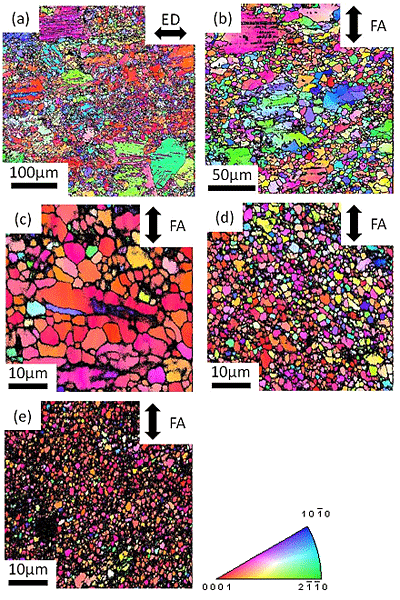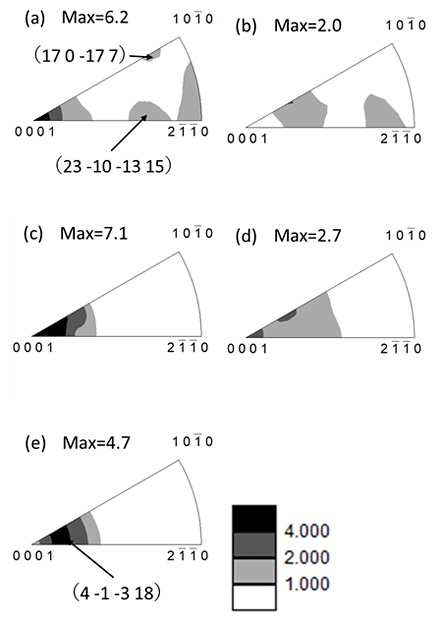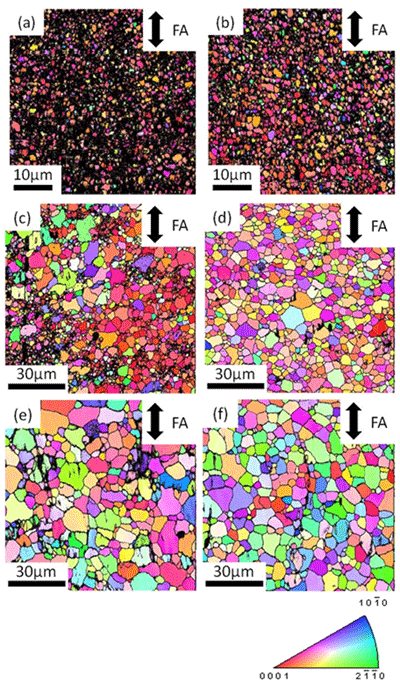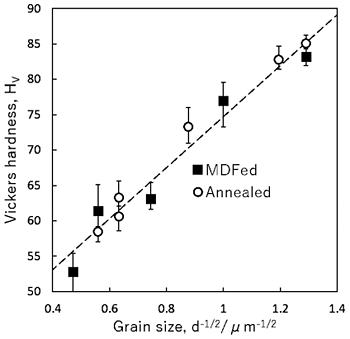Magnesium alloys have a small number of active slip systems at room temperature, because the crystal lattice takes hexagonal closed-packed structure. Therefore, the magnesium alloys are generally classified into one of the materials hard to deform plastically. In order to desire metallic materials with high strength, severe plastic deformation (SPD) methods have been often conducted. Grain refinement achieved by SPD has been an attractive subject from viewpoints of weight reduction and recycling of structural metallic materials. The multi-directionally forging (MDF), which is one of the severe plastic deformation methods, was carried out by Miura et al. for magnesium alloys under decreasing temperature [H. Miura, G. Yu and X. Yang: Mater. Sci. Eng. A, 528 (2011), 6981-6992.]. Miura et al. have investigated the mechanical properties in ultra-fine grain structure formed by MDF under decreasing forging temperature. The dependence of strain rate and temperature on the strength and elongation in as-MDFed specimens were mainly clarified. However, the static recrystallization behavior after annealing in MRFed specimens still remains unresolved. In this study, the relationship between mechanical properties and recrystallized structures after annealing was examined using AZ31F magnesium alloy multi-directionally forged under decreasing temperature.
The chemical compositions of AZ31F magnesium alloy were Al: 2.86, Zn: 0.75, Mn: 0.68, Cu: 0.001, Si: 0.003, Fe: 0.003, and Mg: balance (mass. %). The specimens with a rectangular shape was cut from hot-extruded bar using an electric discharge machine. The dimensions were 15  22.2
22.2  33.3 mm3. The specimens were MDFed using a die equipped with a heater at an initial strain rate of 3.0
33.3 mm3. The specimens were MDFed using a die equipped with a heater at an initial strain rate of 3.0  10-3 s-1. The specimens MDFed to 1, 2, 4 and 6 passes were prepared. The strain imposed in the specimen per pass was Δe=0.8, and the applied cumulative strain after 6 passes corresponded to 4.8. The MDFing temperature was gradually decreased pass by pass of forging from 603K to 433K. Six specimens with a thickness of 0.7mm were cut from the 6 pass-MDFed specimen. These were then annealed at 373, 423, 473, 523, 573, and 623K for 30 minutes, respectively. Vickers hardness tests at a load of 2.942N with a holding time of 15 s were carried out for the MDFed specimens and the annealing specimens. Textures of the specimens were evaluated by an electron back-scatter diffraction (EBSD) method. The hardness test and texture measurement were conducted on a plane parallel to the final forging axis. The plane orientations normal to final forging axis were depicted in the inverse pole figures (IPF) and the IPF maps, which represented the texture and the microstructure, respectively.
10-3 s-1. The specimens MDFed to 1, 2, 4 and 6 passes were prepared. The strain imposed in the specimen per pass was Δe=0.8, and the applied cumulative strain after 6 passes corresponded to 4.8. The MDFing temperature was gradually decreased pass by pass of forging from 603K to 433K. Six specimens with a thickness of 0.7mm were cut from the 6 pass-MDFed specimen. These were then annealed at 373, 423, 473, 523, 573, and 623K for 30 minutes, respectively. Vickers hardness tests at a load of 2.942N with a holding time of 15 s were carried out for the MDFed specimens and the annealing specimens. Textures of the specimens were evaluated by an electron back-scatter diffraction (EBSD) method. The hardness test and texture measurement were conducted on a plane parallel to the final forging axis. The plane orientations normal to final forging axis were depicted in the inverse pole figures (IPF) and the IPF maps, which represented the texture and the microstructure, respectively.
Figure 1 shows the IPF maps of the hot-extruded specimen (a) and the MDFed specimens (b to e). The grain refinement occurred gradually with increasing cumulative strain. The average grain size after 6 passes of MDF was 0.6µm (e). The ultra-fine grains had mainly plane orientations parallel to (0001), which were colored red. Plane orientations without (0001) were also observed in the microstructure.
Figure 2 shows inverse pole figures of the hot-extruded specimen (a) and the MDFed specimens (b to e). The main component of the hot-extruded specimen was (0001), and the minor components were (17 0 -17 7) and (23 -10 -13 15). The specimen MDFed to 6 passes developed (0001) texture, whose the main orientation was (4 -1 -3 18).
Figure 3 shows IPF maps of the specimens MDFed to 6 passes followed by the annealing ranging from 373K to 623K. The grain coarsening occurred with increasing annealing temperature. The specimen annealed at 473K indicated that coarse grains more than 2.5µm in size and fine grains less than 1µm coexisted (c). The coarse grains were regarded as recrystallized grains grown in the annealing at 473K, because these grains were much larger than the grains observed in the as-MDFed specimen shown in Fig. 1(e).
Figure 4 shows inverse pole figures of the specimens after annealing. The specimen after annealing at 373K had a (0001) texture (a), however the specimen at 623K almost random texture, whose the maximum pole intensity was below 2 (f). Thus, in the present conditions of MDF and annealing, the recrystallization texture became almost random after the annealing at 623K.
Figure 5 shows the relationship between hardness and grain size of d-1/2 of the MDFed specimens and the annealed specimens. This diagram indicated that both MDFed and annealed specimens followed the same linear relationship, which was described as Hv=38.7+36d-1/2.




